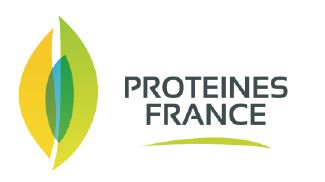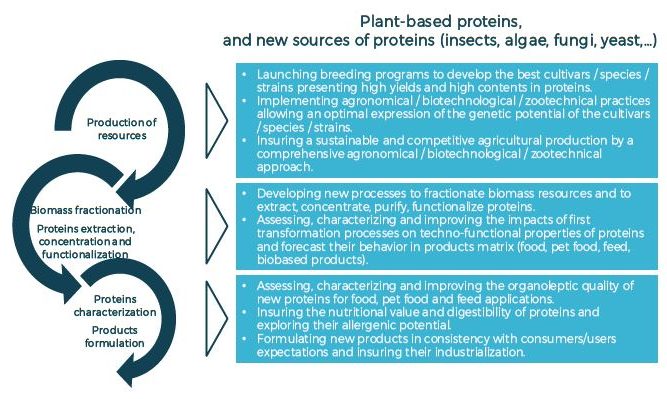Proteins for food, feed and biobased applications (Protéines France)

The bioeconomy encompasses the production of renewable biological resources and their conversion into food, feed, bio-based products (chemicals, materials,…) and bioenergy. Various fractions of the biomass such as sugars, proteins, oils, fibers can be processed through different pathways to deliver biobased products and energy.
Proteins are today mainly used for food, pet food and feed (livestock and aquaculture) purposes due to their nutritional value and at a low degree of concentration (less than 50%). In fact, at a worldwide scale, 800Mtons of proteins are produced and the largest amount of proteins, around 631Mtons, is used for feed. 137Mtons are used for food including a very small amount of proteins concentrates (around 70% of proteins) and isolates (more than 90% of proteins). Finally, around 28Mtons of proteins are used for technical biobased applications (source: Feedsim, 2017).
These figures highlight that proteins are mainly valorized indirectly by humans through animals, and raise two major stakes:

Today, and even more tomorrow, industrials are willing to:
Their ambition is to better valorize proteins in a wide range of applications from ingredients dedicated to the nutrition and the health of humans, pets, and livestock to resources for biobased applications (chemicals, materials,…. These highly valuable proteins are dedicated to international markets and allow more sustainable valorization of biomass resources.
Protéines France roadmap has the ambition to encompasses all these applications.
Proteins can be traditionally found in several raw materials such as meat, fish, crops and dairy products such as milk. Nevertheless, the worldwide demand for protein is progressively expanding. Forecasts to 2050 show that current protein availability will not be sufficient to meet protein demand for food and feed purposes.
A sustainable protein supply for the future can rely on two options:
European crops (cereals, oleaginous and pulses), together with residues and co-products from primary biomass process, are valuable sources of proteins and very good candidates to develop a new offer in plant-based ingredients such as concentrates, isolates and hydrolysates for food, feed and biobased applications.
In the same way, residues from animal processing, fisheries, aquaculture and algae industries also offer a potential, albeit currently underexploited, source of proteins. On top of that, new sources of proteins such as insects, algae, fungi, yeast and bacteria are now considered with a lot of interest for their potential.
As a consequence, Protéines France will support the expansion of the production of protein-rich ingredients by valorizing all these new and existing alternative sources from biomass.
On top of the valorization of the whole protein, Protéines France will also encompass the valorization of some protein fractions, as well as sets of amino-acids (such as enzymes, peptides,… and amino-acids.
Furthermore, Protéines France will consider both native proteins and processed proteins.
In the following chapters, the term « protein » covers all these potential ingredients.
On one hand, proteins from biomass including oilseeds proteins, cereals proteins, legumes proteins, as well as new sources of proteins are still limitedly used in food products compared to animal proteins, even if they present a good potential to provide new and sustainable food ingredients. To meet the market trends and expectations, several technical challenges have still to be overcome.
On the other hand, the demand for feed is booming meaning that the need for alternative protein sources is increasing. Proteins from biomass could provide new and sustainable feed products for animal nutrition. On top of proteins, amino acids are used to supplement the feed ration. In fact, traditional animal feed does not present all the essential amino acids in a sufficient amount so methionine, lysine, threonine and tryptophan are separately added to feed. As well as in food, some bottlenecks have to address to widely use these proteins from biomass in animal nutrition.
The technical challenges Protéines France will address for these markets are the following:
Market trends are very positive regarding proteins for food/pet food/feed applications since they match the needs of consumers. In fact, proteins contribute to a healthy diet, are a good source of energy and have a positive impact of muscle and weight maintenance. Dairy proteins are well established in food and used in more and more products but alternative proteins, especially plant-based proteins are on the rise. Some commercial products made with these alternative proteins have been launched. It appears that consumers’ acceptance, proteins’ taste, as well as products’ texture and appearance still are big challenges to consider mass consumption.
Most proteins are consumed as such, others are extracted and valorized as concentrates and isolates for their functional properties and texturizing properties. One of the key functionality is water solubility, since solubility impacts emulsification, foaming and gel foaming capacities. Unfortunately, many proteins from biomass are poorly soluble in water. As a consequence, their functional properties and texturizing properties have still to be investigated and improved.
The major stakes are linked to the proteins’ nutritional profile, digestibility and bioavailability.
Proteins from biomass can present a lower nutritional value compared to animal proteins. In fact, their proportion of essential amino-acids is not as balanced as in animal proteins. Especially, the concentration of lysine, methionine and cysteine is low. This results for some proteins from biomass in a limited nutritional quality. As a consequence, combining various types of proteins from biomass could be a way to compensate the unbalanced amino acid profile and low nutritional quality of individual proteins.
On top of that, anti-nutritional factors such as protease inhibitors, phytates, glucosinolates, phenolic compounds,… negatively impact the nutritive value of a protein. They can severely affect the digestion, availability and absorption of proteins, as well as absorption of trace elements. Solutions are two-fold:
Finally, proteins from biomass globally present a lower digestibility than proteins from animal sources. On top of that, processes to extract these proteins from biomass negatively impact their digestibility (temperature, moisture,… and bioavailability.
Many native proteins from biomass contain anti-nutrients and allergens causing allergic reactions in 1-2% of the population. Some proteins are identified as major allergens; others may give rise to allergic reactions and others have a very incidence of allergenicity. The knowledge is still limited for a lot of them leading to the need in further investigations, especially for food and pet-food industries.
The allergenicity of processed proteins is also a key issue. A big challenge relies on the characterization of the impacts of processes on allergenicity and on the identification of technical solutions to limit or remove allergenicity.
The expansion of new sources of proteins is strongly linked to the value chain competitiveness and consequently to the protein availability. Insuring a sufficient quantity of biomass implies coping with the following bottlenecks:
These bottlenecks result in a difficulty to compete with some traditional protein sources. The cost of production of alternative sources of proteins has to be reduced implying the development of innovative and productive systems including:
On top of quantity, the quality of the biomass is a key challenge, implying:
1 For feed purposes only
On top of food, pet food and feed applications, some proteins or proteins fractions can be used for technical biobased applications such as adhesives, coatings, surfactants, plastics,… These applications can be very promising for new protein sources or some proteins fractions preventing quality and regulatory limitations linked to food, pet food and feed applications. Nevertheless, many hurdles still have to be solved.
The targeted end application (adhesives, coatings, surfactants, plastics,…) constraints the specific functional property provided by the protein (as well as protein concentrates, isolates and hydrolysates) including water solubility, emulsifying and foaming properties, gelling properties, film foaming properties, adhesion properties, barrier properties for oxygen and carbon dioxide, resistance against solvents…
Replacing synthetic materials by renewable proteins implies characterizing the functional properties of the protein and identifying the mechanisms involved. In terms of technical challenges, it means:
Even if there is an increasing demand for biobased products, the market of green chemicals is still limited and the industrial implementation of such applications requires coping with several challenges:
To sum up the previous sections of this document, projects and topics addressed by Protéines France will cover the whole value chain, as illustrated below:

Protéines France will take full advantage of the successes of earlier and ongoing R&D as well as small-scale industrial operations. Protéines France will both support non-competitive and competitive projects.
Non-competitive projects (also called Projets filières in previous communication supports) can serve the interest of the whole value chain or of a significant number of stakeholders. As a consequence, in a collaborative way, they mainly address the development of new tools, methodologies, approaches, practices,… to foster the development, acceptance or commercialization of proteins.
Their aim is to stimulate and promote French international competitiveness and innovation capacity in the field of proteins sciences, technologies and applications.
These projects are designed to assist teams of researchers from French institutions and industrials, to jumpstart high-impact potential research activities of strategic relevance for the French Proteins for future ambitions. Therefore, they should be high-reward and show promise as well as a strategy for significant future expansion of project goals.
For example, non-competitive projects could address the following topics (indicative and non-exhaustive list):
Competitive projects can serve the interest of one or a limited number of stakeholders. They mainly address the development and the industrialization of new processes, products or services. Technologies entering the scope of these projects have already reached a TRL 4 (small scale prototype built in a laboratory environment) and are supposed to reach the market at a short or medium term (less than 3 years after the end of the project). Competitive projects are led and coordinated by industrials; they can associate partners.
For example, competitive projects could address the following topics (indicative and non-exhaustive list):

Source : protéines France